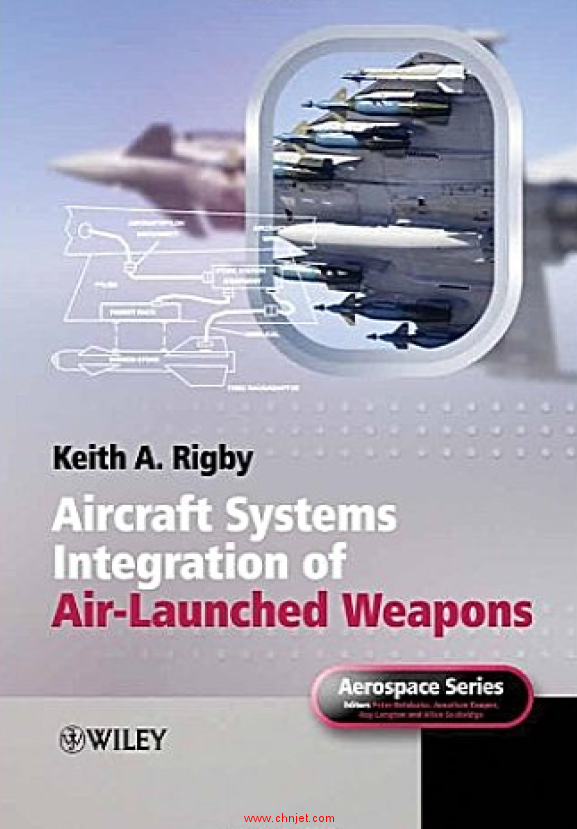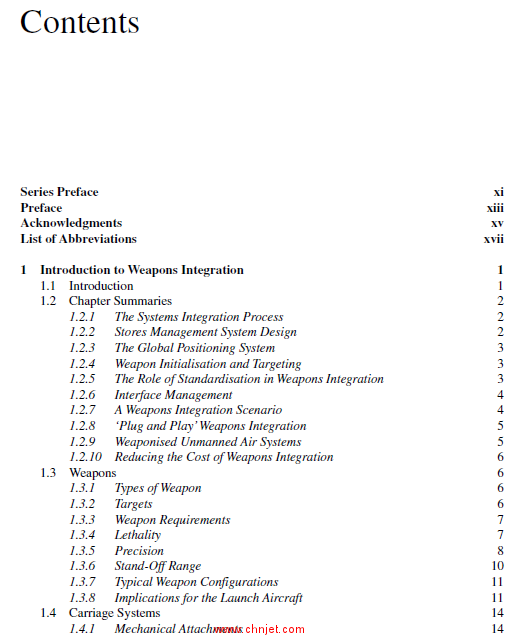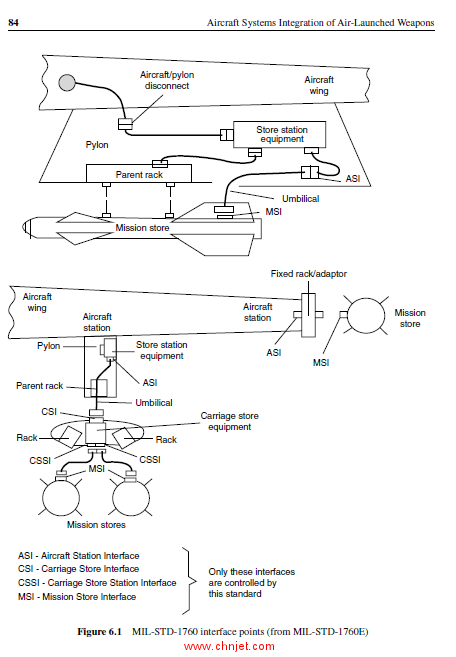马上注册,结交更多好友,享用更多功能,让你轻松玩转社区。
您需要 登录 才可以下载或查看,没有账号?立即注册


x
《Aircraft Systems Integration of Air-Launched Weapons》
空中发射武器的飞机系统集成
作者:Keith A. Rigby
BAE Systems, UK
出版社:Wiley
出版时间:2013年
《Aircraft Systems Integration of Air-Launched Weapons》

《Aircraft Systems Integration of Air-Launched Weapons》

《Aircraft Systems Integration of Air-Launched Weapons》

《Aircraft Systems Integration of Air-Launched Weapons》

目录
Series Preface xi
Preface xiii
Acknowledgments xv
List of Abbreviations xvii
1 Introduction to Weapons Integration 1
1.1 Introduction 1
1.2 Chapter Summaries 2
1.2.1 The Systems Integration Process 2
1.2.2 Stores Management System Design 2
1.2.3 The Global Positioning System 3
1.2.4 Weapon Initialisation and Targeting 3
1.2.5 The Role of Standardisation in Weapons Integration 3
1.2.6 Interface Management 4
1.2.7 A Weapons Integration Scenario 4
1.2.8 ‘Plug and Play’ Weapons Integration 5
1.2.9 Weaponised Unmanned Air Systems 5
1.2.10 Reducing the Cost of Weapons Integration 6
1.3 Weapons 6
1.3.1 Types of Weapon 6
1.3.2 Targets 6
1.3.3 Weapon Requirements 7
1.3.4 Lethality 7
1.3.5 Precision 8
1.3.6 Stand-Off Range 10
1.3.7 Typical Weapon Configurations 11
1.3.8 Implications for the Launch Aircraft 11
1.4 Carriage Systems 14
1.4.1 Mechanical Attachments 14
vi Contents
1.4.2 Downward Ejection 14
1.4.3 Forward Firing 15
1.4.4 Multi-weapon Carriage Systems 15
Further Reading 16
2 An Introduction to the Integration Process 17
2.1 Chapter Summary 17
2.2 Introduction 17
2.3 The V-Diagram 18
2.4 Responsibilities 18
2.5 Safety 20
2.6 The Use of Requirements Management Tools in the Systems
Engineering Process 24
2.7 Weapons Integration Requirements Capture 24
2.8 The Need for Unambiguous, Clear and Appropriate Requirements 26
2.9 Minimising Requirements 29
Further Reading 30
3 Requirements Analysis, Partitioning, Implementation
in Aircraft Subsystems 31
3.1 Chapter Summary 31
3.2 Introduction 31
3.3 System Architecture 33
3.4 Requirements Decomposition 34
3.5 Requirements Partitioning 35
3.6 Subsystem Implementation 36
3.7 Maturity Reviews 37
3.8 Right-Hand Side of the V-Diagram 38
3.9 Proving Methods 38
3.10 Integration 41
3.11 Verification 42
3.12 Validation 42
3.13 The Safety Case and Certification 42
Further Reading 45
4 Armament Control System and Global Positioning
System Design Issues 47
4.1 Chapter Summary 47
4.2 Stores Management System Design 48
4.2.1 SMS Design Requirements 48
4.2.2 Other System Components 50
4.2.3 Typical System Architectures 53
4.2.4 Training System 55
4.3 GPS: Aircraft System Design Issues 59
4.3.1 GPS Overview 59
4.3.2 Satellite Acquisition Concepts 64
4.3.3 Acquisition Strategies 65
Contents vii
4.3.4 GPS Signal Distribution 65
4.3.5 Aircraft Requirements 67
4.3.6 Aircraft Implementation Concepts 68
4.3.7 Cost of Complexity 70
Further Reading 70
5 Weapon Initialisation and Targeting 71
5.1 Chapter Summary 71
5.2 Targeting 71
5.3 Aiming of Ballistic Bombs 72
5.4 Aircraft/Weapon Alignment 73
5.5 Aiming of Smart Air-to-Ground Weapons 74
5.6 Air-to-Air Missiles 76
5.6.1 Sensors 76
5.6.2 Engagement Modes 77
5.6.3 Air-to-Air Weapons Training 78
Further Reading 79
6 Weapon Interface Standards 81
6.1 Chapter Summary 81
6.2 Benefits of Standardisation 81
6.3 MIL-STD-1760 AEIS 82
6.3.1 MIL-STD-1760 Interface Points 83
6.3.2 Connectors 83
6.3.3 Signal Sets 85
6.3.4 GPS RF Signal Distribution 85
6.3.5 Data Protocols 90
6.3.6 Data Entities 94
6.3.7 Time Tagging 94
6.3.8 Mass Data Transfer 95
6.3.9 High-Speed 1760 96
6.4 Standardisation Conclusions 96
Further Reading 97
7 Other Weapons Integration Standards 99
7.1 Chapter Summary 99
7.2 AS5725 Miniature Mission Store Interface 99
7.2.1 Interface Points 99
7.2.2 Connector 101
7.2.3 Signal Set 101
7.3 AS5726 Interface for Micro Munitions 103
7.3.1 Interface Points 103
7.3.2 Connectors 104
7.3.3 Signal Set 104
7.4 Other Weapons Integration Standards 106
7.4.1 Generic Aircraft–Store Interface Framework 106
viii Contents
7.4.2 Mission Data Exchange Format 108
7.4.3 Common Launch Acceptability Region Approach 109
Further Reading 110
8 Interface Management 111
8.1 Chapter Summary 111
8.2 Introduction 111
8.3 Management of the Aircraft/Store Interface 112
8.4 Approaches to Interface Documentation 114
8.5 Interfaces Documented in the ICD 115
8.6 Controlling the Interface of Store Variants 119
8.7 Information Exchange between Design Organisations 120
8.8 Process for Managing Integration Risk 120
Further Reading 124
9 A Weapons Integration Scenario 125
9.1 Chapter Summary 125
9.2 Introduction 125
9.3 The Weapons Integration Scenario 126
9.4 The V-Diagram Revisited 129
9.5 Systems Integration Activities 130
9.6 Safety 132
9.6.1 Aircraft/System Hazards 136
9.6.2 Weapon Hazards 139
9.7 Systems Requirements Decomposition, Design and Implementation 140
9.7.1 Weapon System Integration Requirement 140
9.7.2 Functional Definition and Development/Interface Definition 140
9.7.3 Weapon Interfacing 141
9.7.4 Data Flows between Aircraft Subsystems 143
9.8 Loading to Dispersion Sequence 143
9.8.1 Weapon Loading 145
9.8.2 System Power-Up/Store Discovery 145
9.8.3 Build Inventory 146
9.8.4 Weapon BIT/System Power-Down 147
9.8.5 Download Target Data/Power-Down Weapons 148
9.8.6 Taxi/Take-Off/On-Route Phase 149
9.8.7 Weapon Selection and Priming 149
9.8.8 Update Target Data 150
9.8.9 Steer to Target LAR/Confirm in LAR 151
9.8.10 Initiate Release Sequence 151
9.8.11 Weapon Release Phase 153
9.8.12 Selective/Emergency Jettison 154
9.8.13 Carriage Store Control 155
9.8.14 Training Capability 156
9.8.15 Implications of Aeromechanical Aspects – Weapon
Physical Alignment 156
Further Reading 158
Contents ix
10 A Weapons Integration Scenario: System Proving and Certification 159
10.1 Chapter Summary 159
10.2 Introduction 159
10.3 Simulators and Emulators 160
10.4 Avionic Weapons 160
10.5 Interface Proving 160
10.6 Rig Trials 161
10.7 Avionic Trials 162
10.8 Electromagnetic Compatibility 162
10.9 Airworthiness and Certification 163
10.10 Declaration of Design and Performance/Statement of Design 164
10.11 Certificate of Design 164
10.12 Safety Case 165
10.13 Airworthiness Flight Limitations 165
10.14 Release to Service 165
10.15 User Documentation 165
10.16 Weapon System Evaluation 166
10.17 Conclusion 167
Further Reading 167
11 Introduction to ‘Plug and Play’ Weapons Integration 169
11.1 Chapter Summary 169
11.2 Systems Integration Considerations 169
11.3 The Journey to ‘Plug and Play’ Weapons Integration 171
11.4 ‘Plug and Play’ Technologies 172
11.5 Adoption of ‘Plug and Play’ Technology 172
11.6 Introduction to Aircraft, Launcher and Weapons Interoperability 173
11.7 ALWI Study 174
11.8 ALWI-2 Study 176
11.9 ALWI Common Interface Study 179
11.9.1 Technical Architecture 180
11.9.2 Greater Interoperability through a Common
ICD Approach 181
11.9.3 Common Store Control Service 181
11.9.4 Model-Driven Architecture Approach 183
11.9.5 Implementation Considerations 185
11.10 ALWI Conclusions 186
Further Reading 187
12 Open Systems 189
12.1 Chapter Summary 189
12.2 Introduction 189
12.3 The Contracting and Industry Environment 190
12.4 Current Systems 191
12.5 A Typical Mission Systems Upgrade Programme 192
12.6 ASAAC Architecture 193
12.7 ASAAC and ‘Plug and Play’ 195
x Contents
12.8 Certification Issues 198
12.9 Easing the Upgrade Programme 200
Further Reading 201
13 The Universal Armament Interface 203
13.1 Chapter Summary 203
13.2 Introduction 203
13.3 Objectives of UAI 204
13.4 Fundamental Principles of UAI 207
13.5 Platform/Store Interface 209
13.6 Mission Planning 210
13.7 Launch Acceptability Region 211
13.8 Integration Work Flow 211
13.9 UAI Interface Management 213
13.10 Certification Tools 214
13.11 Benefits 215
13.12 NATO UAI 216
13.13 ‘Plug and Play’ Conclusions 216
Further Reading 217
14 Weaponised Unmanned Air Systems 219
14.1 Chapter Summary 219
14.2 Introduction 219
14.3 Distributed Weapon System 220
14.4 System Architecture Partitioning 222
14.5 Conclusions 226
Further Reading 226
15 Reducing the Cost of Weapons Integration 227
15.1 Chapter Summary 227
15.2 Introduction 227
15.3 The Cost Landscape 229
15.4 Reducing the Cost of Weapons Integration – Other Initiatives 231
15.4.1 Streamlined Integration Processes 232
15.4.2 Common Goals for the ADO and WDO 232
15.4.3 Employment of New Technology Which Eases Integration 233
15.4.4 The Need for Exports 233
15.4.5 Spiral Introduction of Capability 234
15.4.6 Organisational Re-structuring 234
15.4.7 Adoption of International Standards 234
15.5 Conclusions 234
15.6 The Future 236
Further Reading 237
Index 239
专业书籍
下载地址:(回复后可见)
| ![]()
![]()